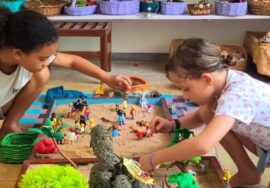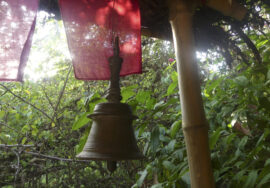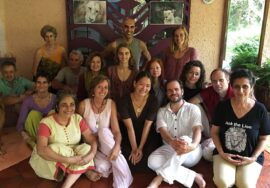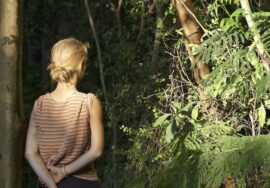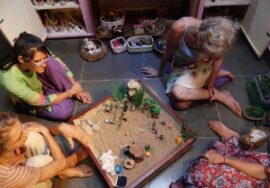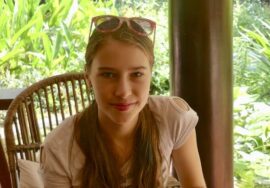Sandplay Traditions in Auroville
— An overview by Heidi Watts
When Aikya told me she was working with World Game, I was delighted, as I believe the ‘sandboxes’ as they are commonly called, represent a special, if not unique contribution to the educational opportunities available for children – or adults – in Auroville.
I was equally delighted when Aikya asked me to write about the history of the World Game in Auroville, as I had done some research into the history of the World Game in 2004-5 when I was writing about the early days of schooling in Auroville. That book was published in 2005 and is called “Little by Little – The Evolution of Schooling in Auroville 1966-1980”.
My information then came primarily from people who were living in Auroville at the time of the founding in 1968 and during the 14 years following. They include Johnny, now in Fertile; Shraddhavan, now the guiding presence at Savitri Bhavan; Miriam from Center Kindergarden; and Jossy, who maintained a special room for the World Game at Transition School for several years in the ‘90s.
The Origins of World Games
In its origin, Sandplay is a psycho-therapeutic tool for children and adults, which originated in England, with a child psychiatrist, Margaret Lowenfeld. Lowenfeld was intrigued by a Game developed by H.G. Wells around 1911 with his children where they created miniature worlds on the floor with small objects. Lowenfeld saw immense possibilities in Well’s ‘Floor Game’ and adapted it for a ‘wonder box’ or sand box, a place where children, less verbal and self-conscious than adults, could freely express their thoughts and feelings through play with objects.
In the mid-fifties, Dora Kalff, a Jungian therapist, went to a conference with Lowenfeld which impressed her strongly. She developed her own version of The World Technique as a tool for adults as well as children to grow toward the Jungian goal of wholeness, a process of evolution to a true integration of the parts of the self.
To distinguish her work from Lowenfeld’s she used the name ‘Sandplay’. There is a wealth of information available through the internet for those interested in learning more about the theory and practice of the World Game or Sandplay. This information was written by Barbara A. Turner from “the Journal of Sandplay Therapists” in 2013.
Although much has been done by succeeding therapists, to test, diagnose, record and interpret Sandplay, Lowenfell’s original intention is similar to the approach used in Auroville today.
She said, “My own endeavor in my work with children is to devise an instrument with which a child can demonstrate his own emotional and mental state without the necessary intervention of an adult either by transference or interpretation, and which will allow of a record being made of such a demonstration. My objective is to help children to produce something which will stand by itself and be independent of any theory as to its nature.”
— Lowenfeld, “Understanding Children’s Sandplay”, 1979
In Aikya’s Sandplay room the children create their own little worlds in the sand box and play out what may happen there.
Sandplay as a psychotheraputic tool
In the mid-fifties, Dora Kalff, a Jungian therapist, went to a conference with Lowenfeld which impressed her strongly. She developed her own version of The World Technique as a tool for adults as well as children to grow toward the Jungian goal of wholeness, a process of evolution to a true integration of the parts of the self
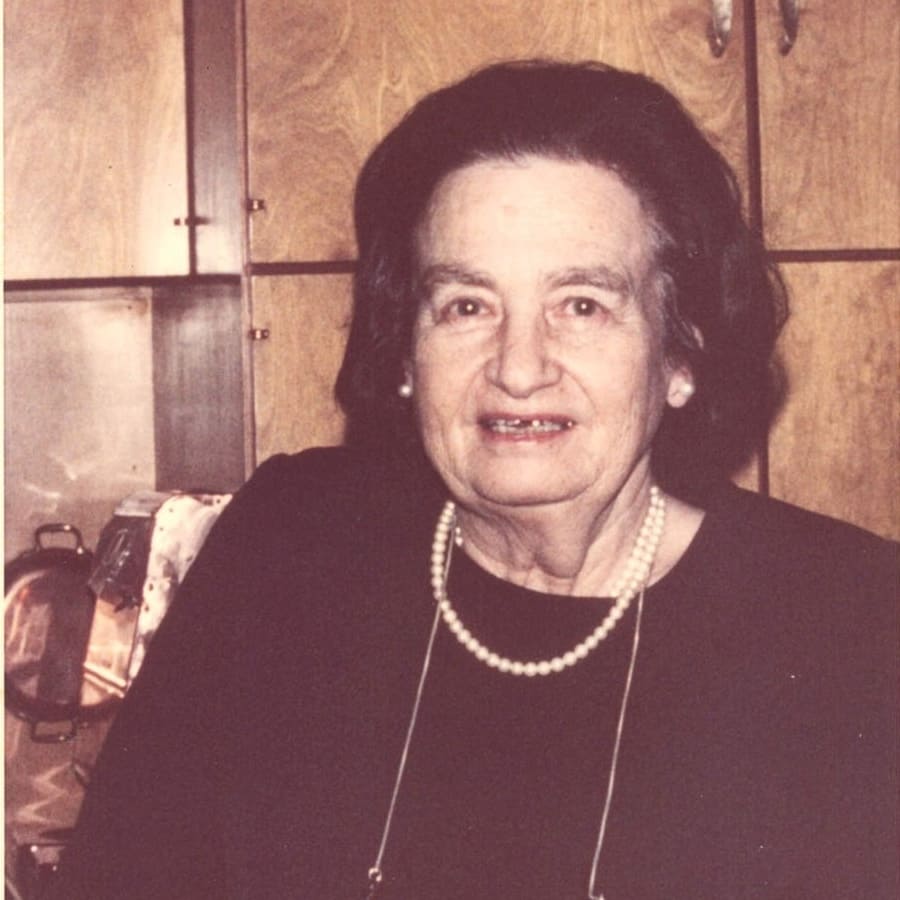
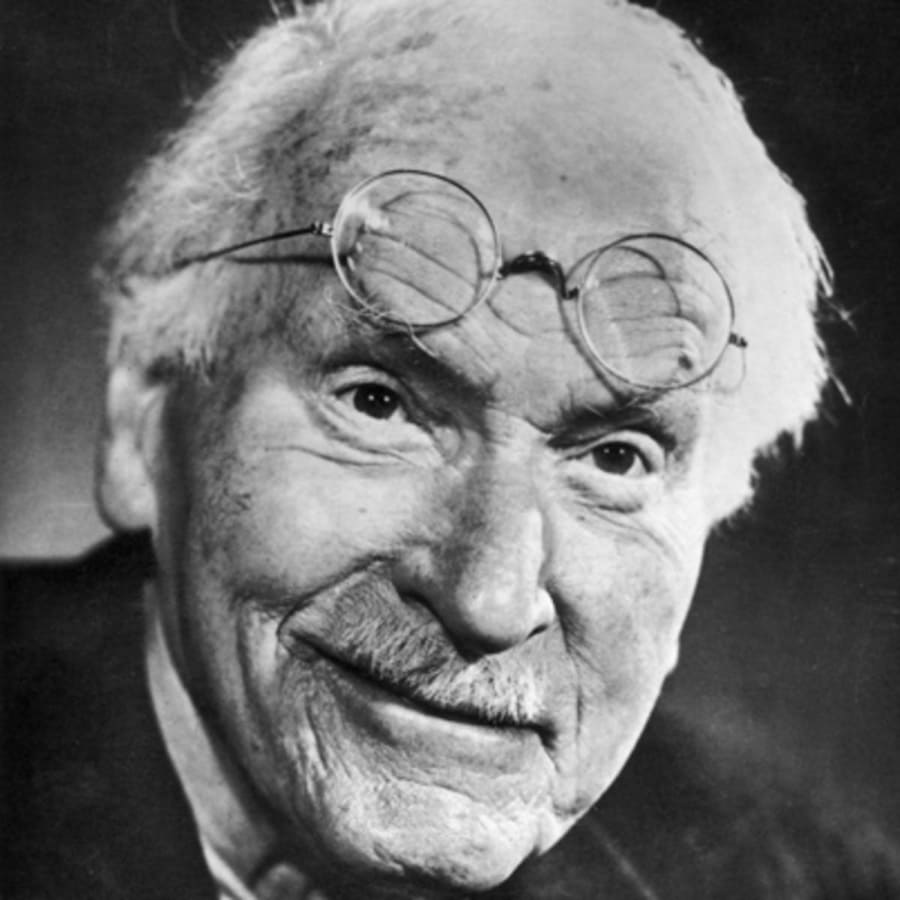
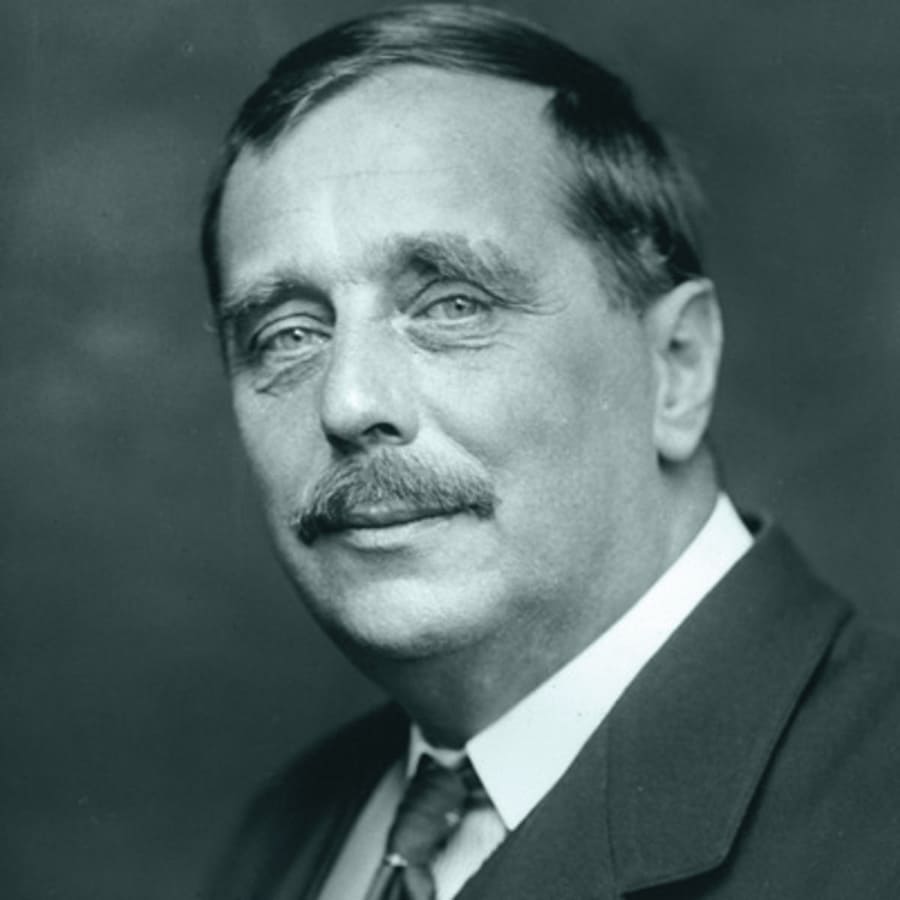

To distinguish her work from Lowenfeld’s she used the name ‘Sandplay’. There is a wealth of information available through the internet for those interested in learning more about the theory and practice of the World Game or Sandplay. This information was written by Barbara A. Turner from “the Journal of Sandplay Therapists” in 2013.
World Games and Auroville
The World Game was brought to Auroville in the early days by an eccentric Jungian psychiatrist, Austin Delaney, who had been working with the sand boxes at Equals-One. He and his wife lived “in a keet castle at Aurobeach, near what is now Quiet”, according to Johnny.
The sandboxes at Aspiration (a school) were housed in keet sheds, where Austin also had stored thousands of little objects which could be used to create scenes and small dramas in the sandbox. After a child completed a sandbox, the teacher drew a picture of the scene and invited (but did not require) the child to talk about it. Making a sandbox in the first place was always voluntary. At one point every child made a sandbox every day.
When the Aspiration School was closed for repairs after the cyclone in 1972, there were school activities for the children in the morning but in the afternoon they worked with the sandboxes, and then, “they really took home.” At a time when there was no common language, the sandbox was a form of self-expression and communication which, like drawing or pantomime, did not require words.
In describing the sandbox activities, Shraddhavan said,
“One way to meet the individual needs of the students was through the sand boxes. We were all the time trying to look at the individual needs of each child. It is amazing what children said through their boxes. They were very helpful in difficult situations.
We believed each child has a psychic being and if it comes to the front it takes education out of our hands and helps them to keep in contact with their true self – so a child can follow the leading of his or her psychic being. This view was in conflict with parents who wanted all the traditional activities for their children at different stages of development.”
When the school in Aspiration closed, the boxes went to Tomas’ house in Certitude where the younger children continued to come for painting, storytelling and work with the sandboxes. The idea was that in addition to helping children release their emotions constructively, the sandbox would also be good for reading and writing: to make, to tell, to write. Later, when most of the school experiments moved to Centre Field in 1980, the sandboxes disappeared, but reappeared later, first at Mirramukhti and then at Transition.
World Games Now
In an article in Ritam, published in the winter of 2005, Jossy describes her work with the sandboxes at Transition now.
“Sand play is actually just what its name implies; it is playing with sand. It is a tool to getting to the imagination and allowing it to become creativity. It is a wonderful instrument, which helps create a link between body and psyche, ma er and spirit. Our hands act as a mediator between inner images and their expression in the outer world: hence the sand tray. It fosters sensitivity to inner images, a condition of relatedness to the inner world, and its concreteness helps create a state of absorption and relaxed concentration. It is a way of objectifying, in the form of symbols, the energy of the unconscious and is very close to the method of active imagination developed by Carl Jung.”
The rectangular box represents the limitations of the world, but the variety of miniatures, people from all times and cultures, animals, houses and castles, trees and flowers, as well as craft materials enable the children to create any world they can imagine within the limitations of the box. The basic equipment for sand play is a rectangular tray, 28” x 19” and 3 inches deep, half lled with sand. The inside of the tray is painted blue so that when an area is exposed it suggests water. Real water may also be used. The children can make whatever they want with these simple materials, lingering over one box for an hour, or making several boxes one after the other. There are no specific instructions, and no distractions to interfere with their concentration.
One valuable feature of Sandplay for a multicultural society such as Auroville is that once within the world of the box the children are free to use or ignore the symbols of the culture they know and to create their own.
“The sandbox world is a symbolic expression of the quest for consciousness that is the first and essential drive for human beings.” – Jossy, 2005
In addition to the expression of inner thoughts and feelings for the child, the sandbox can also be used as an academic tool, encouraging the children to express themselves, first through Sandplay and later through telling, acting and writing. In most cases there is no direct connection but feelings and thoughts released by protected free play in the sandbox can encourage a freer expression in other mediums. Any growth in consciousness will lead to further growth in other domains. The sandbox can be an integral part of an integral education.
“The World Game” was a unique aspect of the curriculum at Aspiration in the early years, and was reintroduced into the Auroville curriculum at Transition by Jossy in 1999. In 2001 Jossy was joined by Paulien, rst as an observer and then as an additional sand box guide at Transition for a few hours a week. While she was learning the Sand Play from Jossy, Paulien opened a room for sand box play at Deepanam, and then moved with the small objects she had collected to the Nandanam Campus, and nally to the site across the road now ocupied by Aha! Meanwhile Paulien’s hours for guiding the Sand Play at Transition gradually increased, until Jossy left her body in March, 2006. Paulien stopped work at Nandenam and took over all the sand box activities at Transition. The Sand Play program at Transition was cut back in July 2014.
The World Game that Aikya describes with such love and care in her book is part of an almost unbroken tradition of sandbox activity for children in Auroville. I hope her book will inspire other schools or centers to consider the possibilities the World Game affords for creativity, self-discovery and the expression of the psychic being.

